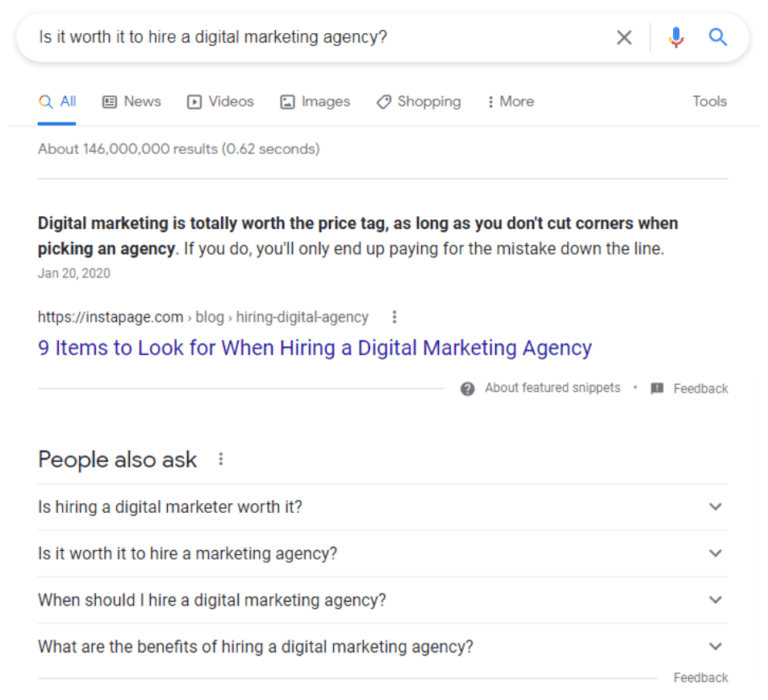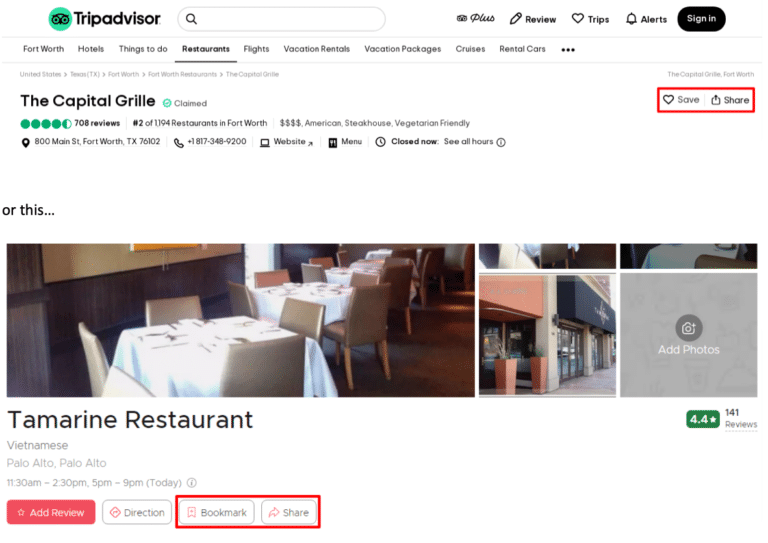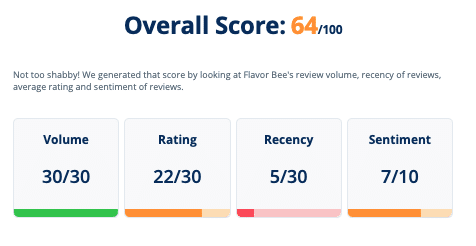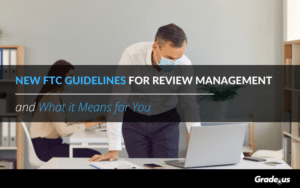Updated 3/2/2022
Agencies are struggling to survive.
According to the 2021 Digital Marketing Agency Outlook, “Finding new clients and retaining current ones is getting harder.”
The good old days of prospecting are long gone.
In our post-Covid world, agencies are forced to fight their way through a hyper-competitive environment. Client loyalty is on the decline, forcing many agencies out of business. If you want to survive, you’ll need actionable strategies you can use to get your foot in your client’s door.
The good news?
Reputation management is an easy way to get your foot in the door, as long as you’ve got the right foundation.
Reputation management is neglected by clients (and agencies)
When you think about it, this makes sense.
Most agencies operate on feast/famine cycles. When they have plenty of clients, they’re flooded with work. They’re overwhelmed, and they’re doing everything they can to keep up. Then, when those clients move on or the work dries up, they’re back to hustling for business and doing what they can to keep the lights on.
It’s a tough way to run a business.
According to the Digital Marketing Agency Outlook:
- 90%+ say finding new clients has gotten harder
- 48% of agencies struggle to find new clients. This is the top challenge
- 42% struggle to increase revenue per account
- 33% struggle to find employees who are a good fit
This is the reality for many, many agencies.
What if it wasn’t?
What if you had the right strategies and tactics you needed to win more pitches?
As it turns out, you do.
Why is it so hard for agencies to win and retain new clients?
Well, for starters, these are the services most agencies offer.
- 52% paid advertising (search, social, etc.)
- 51% SEO
- 43% Design and development
- 38% Full service digital
- 19% Social media marketing
What are the common themes with these services?
- These services typically depend on the retainer, hourly, or project billing model
- Services like creative and development services require a large down payment and lots of trust
- These services are big ticket items — this means longer sales cycles and a lengthy vetting process
- Many clients today prefer to hire specialists for each of these services
- Billing models for these services are optimized, so they decrease agency risk and increase client risk
- There are no guarantees with these services; maybe you get what you pay for, maybe not
Don’t misunderstand me here.
These services are indispensable for your clients. It’ll be hard for clients to grow their business if they ignore these channels. I’m not advocating that you stop offering these services to your clients.
Still, there’s a problem here.
New clients assume almost all of the risk with these services. What’s worse, it’s not immediately clear whether clients will see a return on investment for the work done. So natural clients are a bit cagey about this.
This is precisely why you see searches like these:

Clients need your help.
The searches in the screenshot above didn’t say things like, “How do I get digital marketers to stop calling me?” No, clients want to see that your services will create value for them.
That’s a problem.
Clients typically don’t understand digital marketing as you do. So that means you’ll need to provide them with the kind of services that give them the value they can understand.
The hidden value of reputation management
Research from Moz found businesses risk losing as many as:
- 21.9% of customers if you have just one negative review listed on page one of Google
- 44.1% of customers if you have two negative results
- 59.2% of customers with 3 negative results
- 69.9% of customers with 4 negative results
That’s just Google.
Research from Moz shows that reviews account for 15.44% of how Google ranks a local business.
How do customers feel about your client’s negative reviews?
- 83.5% of shoppers would not do business with a company that has a 3-star rating or below
- 49.7% of consumers need to see a 4-star rating or higher to consider a business
- It takes approximately 40 positive customer experiences to reverse the damage caused by one negative review
- Negative reviews stop 40% of buyers from wanting to use a business
- 19% of the reviews the average business receives are negative
- Companies that improved their Google My Business profile rating from 3.5 to 3.7 stars see conversion growth of 120%
- Businesses with more than 82 total reviews earn 54% more in annual revenue than average.
When clients see this, they get it.
They understand the impact negative reviews will have on their business. They realize these reviews are harmful because they repel Google and customers.
That’s your in.
That’s how you start your pitch.
Business owners need you to pitch them
Negative reviews create pain. Positive reviews, when they’re not managed well, create pain. The non-existent reviews indicate pain. That pain is your opening; it’s a clear indicator that something is wrong.
That’s a very good thing.
That pain means clients are more likely to listen to what you have to say – if your pitch is handled properly. Do it well, and you’re far more likely to win clients over.
That’s the problem.
How are you supposed to pitch small businesses? How do you get local businesses to see the value of what you’re offering?
Step 1: You start with No
You permit clients to tell you “No” right from the start.
That’s insane.
Who in their right mind approaches clients looking for a No? You do if you’re a sophisticated seller.
Here’s why.
The word “No” is a gift. It gives prospects the feeling of control. Of safety and security. But it’s also a wonderful gift for those pitching services.
- “No” flushes out the real issues
- “No” protects us from making bad decisions
- “No” enables us to slow things down so we can analyze our decisions without pressure, baggage, or expectation
- “No” gives us control over our decisions
Typically we’re trained to take a Yes or No response literally. We dread hearing the word No because, in our mind, No equals rejection.
For example, No could mean clients…
- Don’t trust you
- Don’t have enough information to go on
- Can’t afford you
- Are embarrassed or ashamed of the problem
- Aren’t interested
In fact, there’s a long list of things a “No” can mean. But you’ll never be able to figure out what it means if you take it literally.
Does this mean you should become an overbearing spammer who bulldozes the prospects you’re pitching?
LOL, No.
When you hear a “No,” it means you ask for clarification, like this.
“what about my pitch isn’t working for you?”
When you go into your pitch, give prospects permission to say No, and you’re more likely to get to the right kind of Yes. Do that, and you’re ready for…
Step 2: Choosing your targets
When it comes to a cold pitch, specialization is key. Here’s why. Almost every prospect you approach will be skeptical, distrustful, afraid. In their mind, you’re out to take their money.
You know this isn’t true.
You’re smart, so you’ll probably be looking for clients you can serve. You’re looking to make an impact, to dig them out of the hole they’re in.
You need a lead magnet.
A risk-free way these clients can get instant solutions to the problems they’re having. Here’s why that’s so important.
Lead magnets accomplish two important things.
- Solving problems. Clients want the pain to stop. They’re looking for a way to turn things around. A good lead magnet shows them how.
- Training clients. Clients are like kids. They’ll test your boundaries and test you to see if you’re truly an expert.
Lead magnets come in all shapes and sizes. Books, whitepapers, tools, resources, guides, infographics, consults – you name it. A good lead magnet does two things. (1.) solves a problem and (2.) trains your clients to do business your way, ruining them for the competition.
Specialization is key.
Clients are looking for a depth of knowledge; they’re drawn to specialists who understand their business. They tend to avoid generalists who lack specificity.
Creating a lead magnet that’s focused on their specific issues gives you a tremendous amount of credibility and power. Once you have your specialty, you’re ready for…
Step 3: Finding new clients
Let’s say you’ve decided to specialize, focusing your pitch initially on restaurants. You’ll need to choose your geographic area and narrow your search.
- Rural or metropolitan?
- One location or multiple?
- No reviews or lots of negative reviews?
- Mom & Pops or established player?
Finding new clients is easy when you know what you’re looking for. In our example, we’re looking for small Mom & Pops restaurants with a single metropolitan location and a disproportionately high amount of negative reviews.
Next, we head to our list of restaurant review sites. For our example, here we’re looking at sites like…
- Google Reviews
- TripAdvisor
- Facebook pages
- Yelp
- Zagat
- Yahoo Local
- OpenTable
- Zomato
These review sites have something in common. They allow you to save, bookmark or collect businesses. You’ll be asked to sign up for an account before you’re able to bookmark or save restaurants like this…

Once you have an account, start browsing. You can search these review sites directly or speed up your search using Google and advanced search operators like these:
“worst restaurants” AND “location” site:yelp.com
Focus your attention on curating a list of restaurants that meet your target audience criteria. Negative reviews, positive reviews, zero reviews, you can serve them all. When you find a prospect that’s part of your target audience, add them to your list! Use a review scanning tool to create a profile of your contenders. This tells you about the overall sentiment as well as the platform mix for the prospects in your industry (NOTE: this scanning tool is a free feature of Grade.us called Prospect Report).
It looks like this.

These are the businesses you’ll reach out to when you’re ready to…
Step 4: Pitch your targets
It’s time to focus your attention on the businesses you can actually help. A great potential client…
- Is teachable or willing to help others
- Is not abusive, corrosive, or toxic
- Realizes they have a serious problem
- Feels overwhelmed with customer responses
- Knows they’re in over their head
Avoid toxic clients like the plague. You’re looking for clients who don’t know how to solve their problem. Looking at their reviews, this should be fairly obvious.
- If they have negative reviews, your pitch should amplify the problem and the consequences of doing nothing. Your pitch should show them why they need help from an authority like you.
- What if they have lots of positive reviews? Believe it or not, they need even more help. Show them how the reviews they’re already getting can increase the amount of traffic, leads, and sales they receive. Show them how you’ll use reviews they already have to decrease their cost per lead/click dramatically. Use specificity to boost credibility and increase your persuasive force.
- Maybe they have zero reviews. Maybe they’re completely in the dark about review management. Believe it or not, this scenario is the easiest approach to take. There are no misconceptions to fix, no myths to bust, no bad habits to undo. So how do you make your approach? Include feedback from existing or potential customers in your pitch. Both negative and positive feedback amplify your argument’s strength, especially if their own customers have something specific they want to say.
Whatever their situation, you’re looking for ideal customers. They must meet your criteria. Use demographics, psychographics, culture, company/psychological profiles to find the customers you’re looking for.
Dump any prospect that fails to meet your criteria.
Next, approach potential candidates with an irresistible offer. This depends largely on you, your business, and the incentives you’re willing to make.
You could offer, for example…
A 50 percent increase in positive reviews or your money back!
Are you coaching clients to give you a bad review? Take our quiz to find out!
We’ll show you how to boost customer traffic to your site using reviews you already have for free!
Use this strategy to win 30% of your negative reviewers back!
An irresistible offer solves a problem, giving clients something they desperately want. How are you supposed to figure that out?
Easy, you ask.
You reach out to a client on your list and ask for a 5-minute interview. Then you ask about details that matter to them.
- What scares them the most about negative reviews?
- How do they handle negative reviews now?
- How many of their negative reviewers buy again?
- What do you want customers to write in their reviews?
Then, sit back and listen.
Once you have the answers you’re looking for; you’re ready to make your pitch.
Just one problem.
What do you say, and how do you say it? That’s easy too. You simply feed new clients the answers you received from your interview, like this.
The baited pitch
Subject: You lost these customers. Do you want them back?
Hey [Prospect],
What if I could show you how to win 30 percent of your customers back? You know, the ones who left you after leaving a negative review. What if I showed you how, free of charge?
Here’s how it works.
I’ll give the first 10 people to respond immediate help, and I’ll guarantee an improvement of [##%] within [## days]. Free of charge.
Would you be interested?
[Signature]
P.S. No pressure here. Feel free to say No if this isn’t right for you.
The no-nonsense pitch
Subject: You stand to lose 44.1% of your traffic from Google.
[Hi Name,]
A reviewer by the name of [reviewer name] just posted this negative review about your business on Yelp. This review (and 16 others like it) will appear in Google and Bing within 48 hours.
You stand to lose 44.1% of your traffic from Google.
Here’s a screenshot of my team’s [report] on your business. If you’re interested, I’ll give it to you (no opt-in required). I’ll also show you how to:
1.] Fix the problem fast (typically within a week)
2.] Use your worst reviews to boost leads by at least [##%]3.] Flood your business with low cost, high-quality leads (averaging $$ to $$ in your industry).
I’ll give you the report and do this free of charge if you’re one of the first [10] people to get in touch.
Just ask for [first name last name], (that’s me). I’m the [title] at [agency].
Interested?
[Signature]
The trends pitch
Subject: Yikes. 90% of your customers said this horrible thing about you
[Hi Name,]
You’ve received [###] negative reviews in the last [##] months.
90% of your customers said this about you.
[Their hotel is filthy, and the beds are full of fleas]
I can help you turn these negative reviews into revenue.
I can help you generate:
- [37%] more four and five-star reviews in less than 30 days.
- [75%] more four and five-star reviews in 45 days.
- [120%] more four and five-star reviews in 90 days.
I’ll do this free for the first 30 days.
My name is [first name last name]. I’m the [title] at [agency].
Would you be willing to give me a shot?
[Signature]
See what I did with these?
I gave them an irresistible offer that included:
- An invitation to say No
- An irresistible offer
- Urgency triggers
- Fear of loss
- Phrasing that positions you as an authority
My pitch was short and sweet, getting right to the point. Include these items in your pitch, and your conversion rate shoots way up.
What happens afterward?
You send clients to your lead magnet, where they’re given two choices, convert or leave.
Those who convert receive more content via an autoresponder sequence, selling them on the value of your product or service. You receive a consistent stream of fresh, ready-to-buy leads from people who are interested in receiving your quote or proposal.
Step 5: Don't give your clients the proposal!
You’ll want to disqualify your prospects before you even begin writing them a proposal. You need to identify which prospects are time wasters and which ones are serious.
How do you do that?
You ask them two questions during the qualification process.
(1.) “Mr./Ms. Prospect,
Let’s say I deliver the perfect pitch (or proposal). Let’s say I can answer all of your questions, concerns, and objections. Let’s also say the price is perfect.
What will you do next?”
There’s really only one right answer.
They’re going to sign on the dotted line. Any other answer from your prospect, and you’re dealing with a waffler. Your pitch is probably going to fail. If they say sign on the dotted line, you ask the next question.
(2.) “Mr./Ms. Prospect,
Can we set a time to go over the proposal together?”
Again, there’s really only one right answer.
“Sure, I’m available on…” Any other answer from your prospect and you’re dealing with, you guessed it, a waffler.
If your prospects give you the right answer for both of these questions, you go ahead and write the proposal or quote.
Never before.
Your time is too valuable to deal with wafflers who are simply interested in using your agency as leverage to hire their favorite or to get a better price somewhere else.
There’s one last problem.
A cold pitch won't work
Cold calling, cold pitching, these strategies don’t work anymore. That’s the fear, right? Inbound marketing is where it’s at.
That’s the thing.
This is inbound marketing. You’re using your pitch to drive clients to content in the form of a lead magnet. That offer leads to a follow-up sequence, which leads to a sale.
That’s all inbound marketing. And inbound marketing works.
It’s no different here.
You’re not approaching clients with a solution to a non-existent problem. You’re focusing on clients who’ve received a painful reminder on the importance of online review management.
These clients know reviews shouldn't be ignored
They’re in the trenches, dealing with one unhappy customer after another; they aren’t managing their reviews well.
Because they don’t know how.
But it wouldn’t really matter if they did. They’re too busy putting out fires, running from one problem to the next. They know they need help from a professional. Someone who can make the pain stop and the profits flow.
They need you.
Approach these clients with an irresistible offer, and they’ll see review management as the profit center it is. Attract a flood of positive reviews from happy customers, and your expertise becomes priceless.










